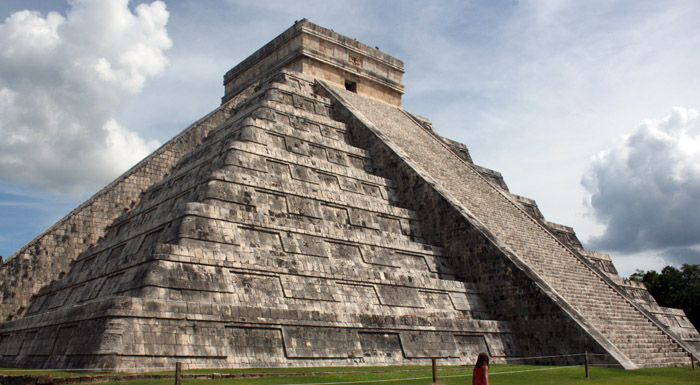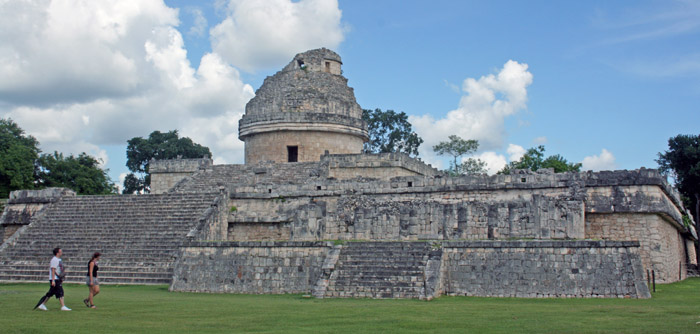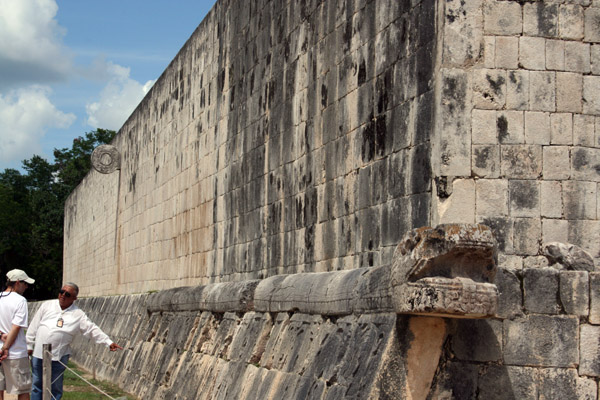Chichén Itzá
By Edit Grof-Tisza, December 2010
Pyramid of Kulkulcan at Chichen Itza. Photo credit Edit Grof-Tisza

Chichén Itzá’s history is full of fascinating events, features and facts concerning its origin, location, and the structure of the city. Its past contains a little bit of mystery (especially regarding the abandonment of the city), but its present – with its magnificent restored monuments – still provides opportunity to admire the greatness of the ancient Maya.
Chichén Itzá was a Maya religious center on the Yucatán Peninsula. It was built on a limestone plain next to two natural wells, called cenotes, which probably made the area more favorable for settling. According to the Maya writings in the Books of Chilam Balam, by the tenth century nautical people had reached the Yucatán Peninsula. As to who these foreigners were, different theories have been developed. According to one theory, one of these groups, the Putún Maya, had a branch called the Itzá, who ventured inland by 918 AD (Lawana Hooper Trout, The Maya (1991), 67). Another theory assumed that the Putún Maya and the Itzá were not the same group but had just arrived along one another from the Gulf Coast state of Tabasco, or maybe they were allied with the Toltecs from Tula (Lila Perl, The Ancient Maya (2005), 66). Whatever their origin though, they settled by the bigger of the previously mentioned natural wells, the great cenote, which was known as "Wuk Yabnal" (Abundance Place) (Sacred Sites: Places of Peace and Power). The name “Chichén Itzá” means “Opening/mouth of the well of the Itzá” and refers to the Itzá people and the location where they settled. Chichén Itzá became one of the most influential Maya states in Mesoamerica and remained that until about the twelfth century.
The location played a very important role in the establishment of this Maya center. The great well or Sacred Cenote was significant not only because it was one of the few water resources for the people, but also because it served as a key sacred site. The Maya threw valuable things (made of gold, jade, obsidian, copper, ceramic, etc.) in the well as well as human sacrifices (mainly children and men). The offerings were made to the Maya gods, particularly to Chaak, the Rain God. This natural well was almost perfectly round, its diameter almost 200 feet, and the deepest part a little less than 270 ft. (Chichen Itza – Cenote Sagrado). Even after the abandonment of the city as a political center around the beginning of the twelfth century, the well remained a pilgrimage center until after the Spanish conquest (Lynn Foster, Handbook to Life in the Ancient Maya World (2002), 106).
The structure of Chichén Itzá resembled the other city-states in the Maya Kingdom with a large urban center and surrounding farming communities. The urban center contained pyramids, temples, and great monuments. Chichén Itzá was originally built in the classical Mayan style between the seventh and tenth centuries ce, then later Mayan-Toltec elements and architectural pieces were added between the tenth and thirteenth centuries ce (Gail Bellenger, The Mayan City of Chichen Itza). At its peak, the city's area covered about six square miles. Though most of the structures were destroyed in wars and/or lost to the hands of time, about thirty remained for people to see in present days. Ruins from the former period contained lesser-known buildings like the Nunnery or the Church (La Iglésia), while the later period left very well-known structures, like El Castillo (the Pyramid of Kulkulcan), the Caracol Observatory, or the Great Ball Court.
One of the most famous structures of Chichén Itzá is without a doubt the Pyramid of Kulkulcan or El Castillo (see above). It was built on the foundations of other temples between the eleventh and thirteenth centuries (Kulkulcan is the Maya name for the god Quetzalcoatl, “Feathered Serpent”). The pyramid is 24 meters tall, ending in a flat platform. On top of this, there is a two-story temple, which adds another 6 meters in height. The pyramid was essentially a nine-step structure, with a wide, steep staircase on each of the four sides, each containing 91 steps. The four sets of 91 steps added together with the platform total 365--the number of days in a year. Some Maya structures were built in a way to either line up with the sun or stars, or to be suitable to study the sky. El Castillo was lined up with the path of the sun in such a way that on the vernal and autumnal equinoxes a shadow on the northern stairway is cast by the setting sun on the edge of the nine-level staircase (Irene Flum Galvin, The Ancient Maya (1997), 34). The shadow lines up with the snake head on the bottom of the pyramid, which creates the image of a snake slithering down.
The Caracol Observatory (see below) is an example of how important it was to the ancient Maya to observe the movements of the sun, moon and the stars. The Caracol was built so that the Maya could make precise measurements of the position of Venus. The name of the structure means “snail,” referring to the spiral staircase inside it. One of the fascinating facts about this observatory is that it is the only round structure found around at the site. The observatory “worked” the following way: “the narrow slots built into the observation tower of El Caracol accurately align with the location of Venus when it reaches the horizon at the most northerly and southerly extremes of its path through the sky. Another window was used to track the horizon position of the sun at sunset” (Karen M. Strom, El Caracol.
In Chichén Itzá (like in other city-states) the Maya played ritual ball games, which were called “pok-a-tok”. The city had a minimum of seven ball courts (some sources mention 12, 13 or even 22), among them is the Great Ball court (see image further below), which was the biggest one in Mesoamerica, measuring 545 by 223 ft. (Nancy Day, Your Travel Guide to the Ancient Maya (2001), 29). The interesting thing about the Great Ball Court, besides its size, is that its walls were not slanted like any other ball court, but vertical. The stone ring through which the players had to get the ball was located toward the top, about 23 feet above the ground. The game was played with a small, heavy rubber ball which the players were not allowed to touch with their hands or their feet. The ancient Maya did not play this ball game as a sport. It was part of a religious ritual with the losers losing their lives (they were often sacrificed). According to other theories, the captain of the winning team was the one who got the “honor” to get decapitated and sacrificed. The seriousness of this game was depicted on the relief sculptures at the base of the Great Ball Court, in which the captain of the winning team was holding the cut-off head of the captain of the losing team (or vice versa, depending on which theory was the “correct” one).
Chichén Itzá’s history, however great it may have been, has left some questions unanswered. One of these mysteries is why the Maya abandoned their cities (including Chichén Itzá). There are some ideas what might have caused them to leave but nothing has been proven conclusively. One speculation is that the population grew, and there was not enough food to support the cities (Jane Shuter, The Maya (2009), 30). Others believe that war was the reason, or perhaps the Maya simply just repeated the pattern of earlier times when they left their cities and moved to new areas (Irene Flum Galvin, The Ancient Maya (1997), 15). Whatever their reason, the Maya left, and many of their impressive buildings deteriorated or got destroyed. Fortunately some of these constructions and monuments have been restored by the Mexican Government and the Carnegie Foundation.
Chichén Itzá’s history contains many intriguing theories about the origin, location, and the architecture of the city. Its past is also somewhat mystical, which makes it all the more interesting. As a UNESCO World Heritage Site today, this once great city-state, with its grand structures, still reflects the magnitude of the achievements of the ancient Maya.

El Caracol (The Astronomical Observatory) at Chichen Itza. Photo credit Edit Grof-Tisza
See some more Chichén Itzá images.
Bibliography
- Coe, Michael D. The Maya. New York: Thames & Hudson, 2005
- Day, Nancy. Your Travel Guide to Ancient Mayan Civilization. Minneapolis: Runestone Press, 2001
- Foster, Lynn V. Handbook to Life in the Ancient Maya World. New York: Facts On File, Inc., 2002
- Galvin, Irene Flum. The Ancient Maya. Tarrytown, NY: Benchmark Books, 1997
- Hinsdale, Joshua Eden. Playa Del Carmen, Tulum &the Riviera Maya. Woodstock, VT: The Countryman Press, 2009
- Hutchison, Peter. Central America & Mexico Handbook. USA: Globe Pequot Press, 2009
- Maloy, Jackie. The Ancient Maya. New York: Children’s Press, 2009
- Peppas, Lynn. Life in Ancient Mesoamerica. New York: Crabtree Publishing Company, 2005
- Perl, Lila. The Ancient Maya. USA: Franklin Watts, 2005
- Scholl, Elizabeth. How?d They Do That? in The Mayan Civilization. USA: Mitchell Lane Publishers, Inc., 2010
- Shuter, Jane. The Maya. Chicago: Heinemann Library, 2009
- Takacs, Stefanie. The Maya. USA: Scholastic, Inc., 2003
- Trout, Lawana, Hooper. The Maya. USA: Chelsea House Publishers, 1991

This is the stone ring at the center of the Great Ball Court (the game that the Maya played) at Chichen Itza. Photo credit Edit Grof-Tisza
Websites:
- Bellenger, Gail. The Mayan City of Chichen Itza. Accessed 4 October 2006.
- Chichen Itza (World Heritage List)
- Finney, Dee. Mayan Games: The Dream and the Reality
- Hirst, K. Kris. Stone Ring at Ball Court: Chichén Itzá
- Chichén Itzá – Cenote Sagrado
- Sacred Sites: Places of Peace and Power. Chichen Itza
- Strom, Karen M. El Caracol
- Mystic Places: Chichen Itza
- Wiki entry for Chichen Itza